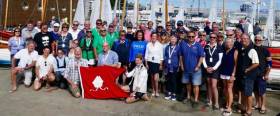Displaying items by tag: Treardur Bay Sailing Club
Happy Hundredth Birthday, Treardur Bay Sailing Club
It’s exactly a hundred years to the day from the establishment of the thriving Treardur Bay Sailing Club at its rocky cove in west Anglesey in North Wales on August 23rd 1919 writes W M Nixon. Back then, the world was only beginning its struggle to recover from the full horror of the Great War of 1914-1918, and events like the formation of a new sailing club were vital to assist the proper return to normal life.
Thus we extend our warmest good wishes across the Channel to a keen group of sailors who brought two boat classes – the Myth 14ft dinghy class founded in 1920, and the Seabird Half Raters from 1898 – to be a much-appreciated presence at the Volvo Dun Laoghaire Regatta 2019 in July, and we wish them well as they launch into their second century tonight.
 Vintage boats in Dublin Bay – at the VDLR 2019 are Treardur Bay Seabirds (1898), Howth 17s with jackyard topsails (1898), and Dublin Bay Mermaids (1932)
Vintage boats in Dublin Bay – at the VDLR 2019 are Treardur Bay Seabirds (1898), Howth 17s with jackyard topsails (1898), and Dublin Bay Mermaids (1932)
And if you wonder what it’s like to sail from a southwest-facing rocky cove on the Welsh coast protected only by reefs, rocks and islets, then this vid from 2018 gives some idea of what sailing can be like when the wind eases a bit after a period of heavy onshore weather at Treardur Bay. The red sails are on the Myths from 1920, and there’s a glimpse of the historic Seabirds out at sea beyond the rocks.





























































